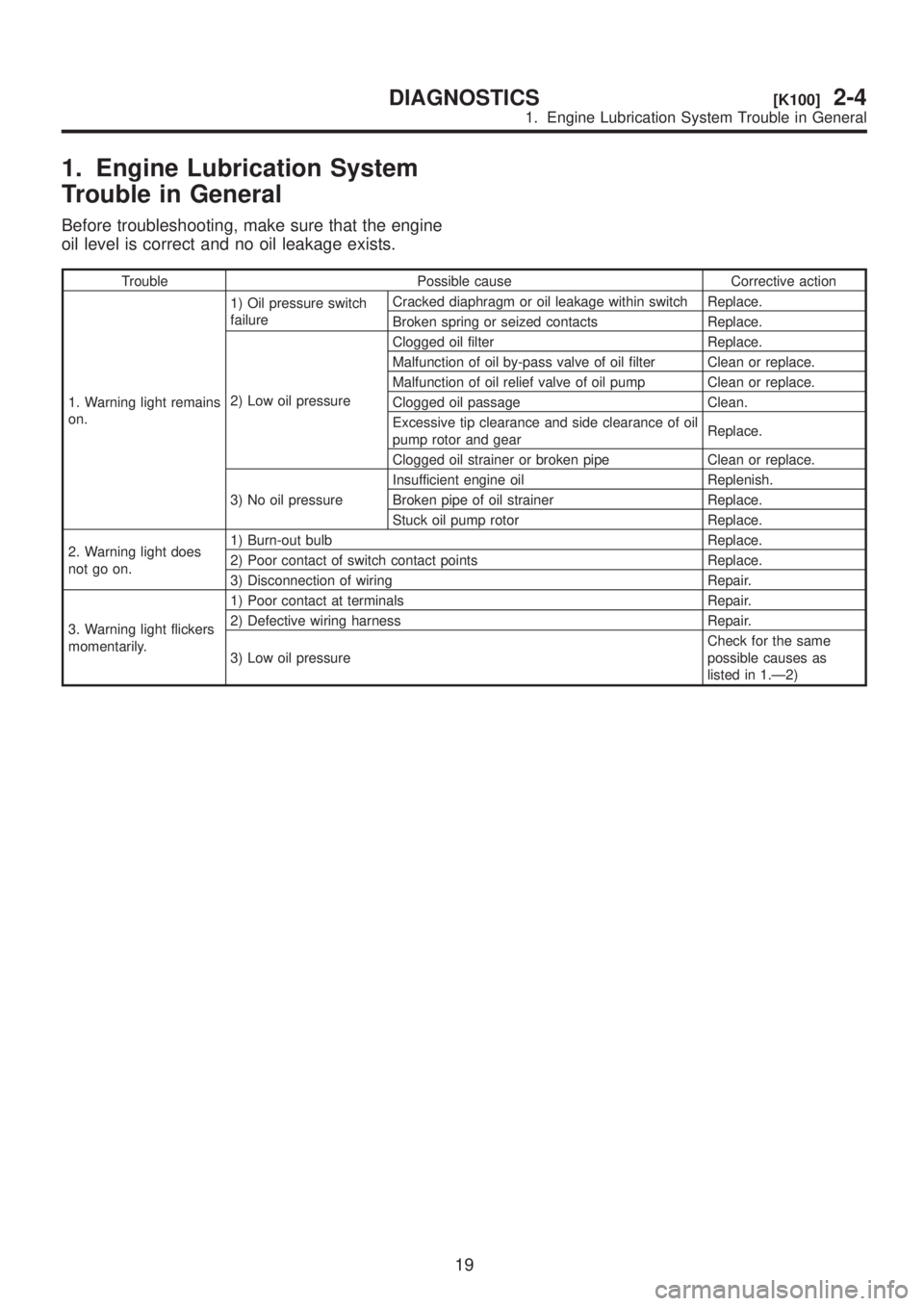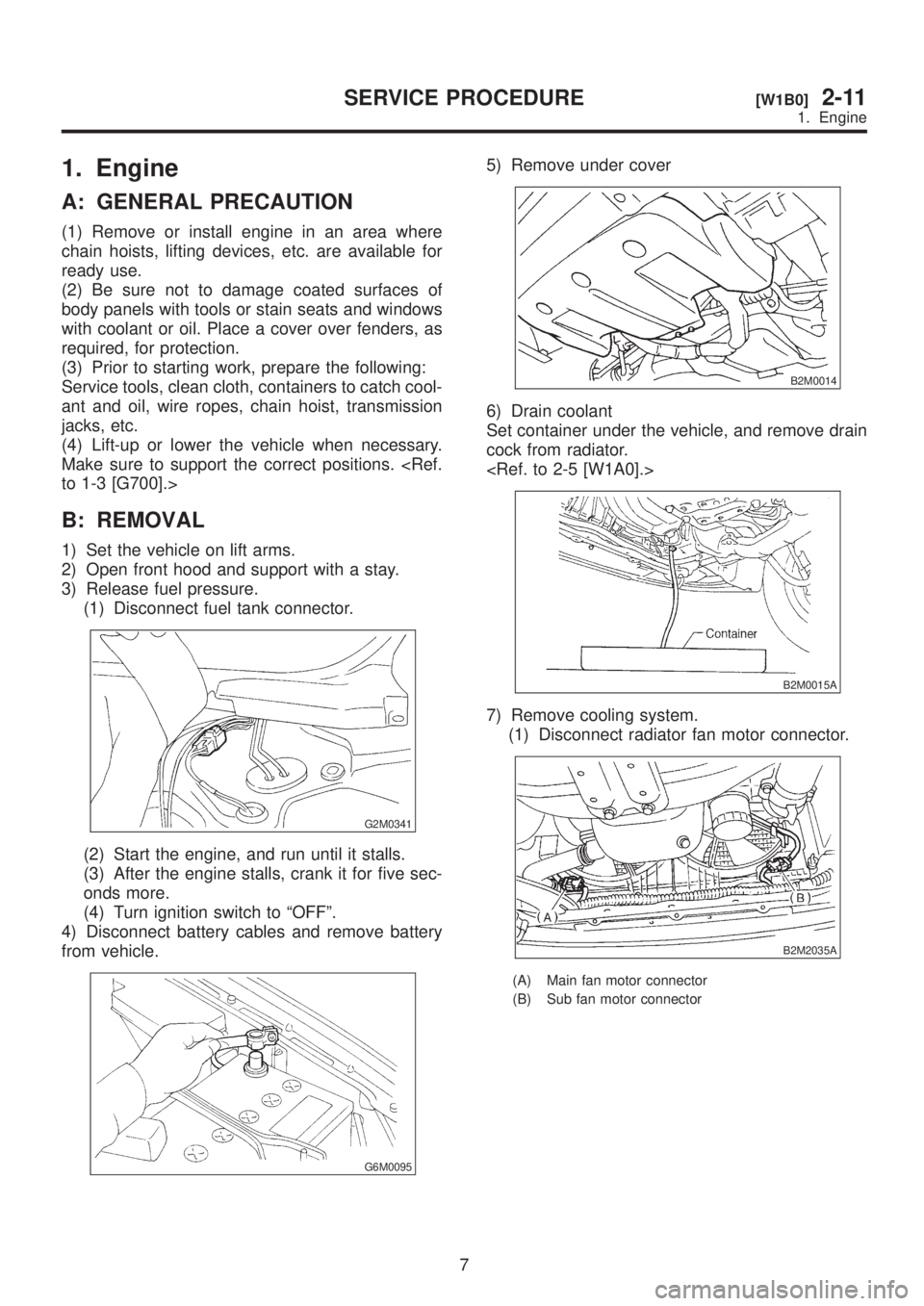Page 223 of 1456
15) Install radiator upper brackets.
Tightening torque:
18
±5 N´m (1.8±0.5 kg-m, 13±4 ft-lb)
B2M0320
16) Install air intake duct and air cleaner assem-
bly. (2200 cc California spec. vehicles)
B2M2771
17) Install air intake duct and air intake chamber.
(Except 2200 cc California spec. vehicles)
B2M2772
18) Fill engine oil through filler pipe up to upper
point of level gauge.
Engine oil capacity:
2200 cc ; Upper level
4.0
(4.2 US qt, 3.5 Imp qt)
2200 cc ; Lower level
3.0
(3.2 US qt, 2.6 Imp qt)
2500 cc ; Upper level
4.5
(4.8 US qt, 4.0 Imp qt)
2500 cc ; Lower level
3.5
(3.7 US qt, 3.1 Imp qt)
3. Oil Pressure Switch
A: REMOVAL
1) Remove alternator from bracket.
(1) Disconnect connector and terminal from
generator.
H6M0402
(2) Remove V-belt cover.
B2M0017
(3) Loosen lock bolt and slider bolt, and remove
front side V-belt.
(4) Remove bolts which install generator on
bracket.
H2M1499
16
2-4[W3A0]SERVICE PROCEDURE
3. Oil Pressure Switch
Page 224 of 1456
15) Install radiator upper brackets.
Tightening torque:
18
±5 N´m (1.8±0.5 kg-m, 13±4 ft-lb)
B2M0320
16) Install air intake duct and air cleaner assem-
bly. (2200 cc California spec. vehicles)
B2M2771
17) Install air intake duct and air intake chamber.
(Except 2200 cc California spec. vehicles)
B2M2772
18) Fill engine oil through filler pipe up to upper
point of level gauge.
Engine oil capacity:
2200 cc ; Upper level
4.0
(4.2 US qt, 3.5 Imp qt)
2200 cc ; Lower level
3.0
(3.2 US qt, 2.6 Imp qt)
2500 cc ; Upper level
4.5
(4.8 US qt, 4.0 Imp qt)
2500 cc ; Lower level
3.5
(3.7 US qt, 3.1 Imp qt)
3. Oil Pressure Switch
A: REMOVAL
1) Remove alternator from bracket.
(1) Disconnect connector and terminal from
generator.
H6M0402
(2) Remove V-belt cover.
B2M0017
(3) Loosen lock bolt and slider bolt, and remove
front side V-belt.
(4) Remove bolts which install generator on
bracket.
H2M1499
16
2-4[W3A0]SERVICE PROCEDURE
3. Oil Pressure Switch
Page 227 of 1456

1. Engine Lubrication System
Trouble in General
Before troubleshooting, make sure that the engine
oil level is correct and no oil leakage exists.
Trouble Possible cause Corrective action
1. Warning light remains
on.1) Oil pressure switch
failureCracked diaphragm or oil leakage within switch Replace.
Broken spring or seized contacts Replace.
2) Low oil pressureClogged oil filter Replace.
Malfunction of oil by-pass valve of oil filter Clean or replace.
Malfunction of oil relief valve of oil pump Clean or replace.
Clogged oil passage Clean.
Excessive tip clearance and side clearance of oil
pump rotor and gearReplace.
Clogged oil strainer or broken pipe Clean or replace.
3) No oil pressureInsufficient engine oil Replenish.
Broken pipe of oil strainer Replace.
Stuck oil pump rotor Replace.
2. Warning light does
not go on.1) Burn-out bulb Replace.
2) Poor contact of switch contact points Replace.
3) Disconnection of wiring Repair.
3. Warning light flickers
momentarily.1) Poor contact at terminals Repair.
2) Defective wiring harness Repair.
3) Low oil pressureCheck for the same
possible causes as
listed in 1.Ð2)
19
[K100]2-4DIAGNOSTICS
1. Engine Lubrication System Trouble in General
Page 260 of 1456

1. Engine Cooling System Trouble in General
TroubleCorrective action
Over-heatinga. Insufficient engine coolantReplenish engine coolant, inspect for leakage, and
repair.
b. Loose timing belt Repair or replace timing belt tensioner.
c. Oil on drive belt Replace.
d. Malfunction of thermostat Replace.
e. Malfunction of water pump Replace.
f. Clogged engine coolant passage Clean.
g. Improper ignition timingInspect and repair ignition control system.
On-Board Diagnostics II System
h. Clogged or leaking radiator Clean or repair, or replace.
i. Improper engine oil in engine coolant Replace engine coolant.
j. Air/fuel mixture ratio too leanInspect and repair fuel injection system.
On-Board Diagnostics II System
k. Excessive back pressure in exhaust system Clean or replace.
l. Insufficient clearance between piston and cylinder Adjust or replace.
m. Slipping clutch Repair or replace.
n. Dragging brake Adjust.
o. Improper transmission oil Replace.
p. Defective thermostat Replace.
q. Malfunction of electric fanInspect radiator fan relay, engine coolant temperature
sensor or radiator motor and replace there.
Over-coolinga. Atmospheric temperature extremely low Partly cover radiator front area.
b. Defective thermostat Replace.
Engine coolant
leaks.a. Loosened or damaged connecting units on
hosesRepair or replace.
b. Leakage from water pump Replace.
c. Leakage from water pipe Repair or replace.
d. Leakage around cylinder head gasket Retighten cylinder head bolts or replace gasket.
e. Damaged or cracked cylinder head and crank-
caseRepair or replace.
f. Damaged or cracked thermostat case Repair or replace.
g. Leakage from radiator Repair or replace.
Noisea. Defective drive belt Replace.
b. Defective radiator fan Replace.
c. Defective water pump bearing Replace water pump.
d. Defective water pump mechanical seal Replace water pump.
26
2-5[K100]DIAGNOSTICS
1. Engine Cooling System Trouble in General
Page 290 of 1456
25) Disconnect connector from crankshaft position
sensor.
B2M1252A
26) Disconnect connector from oil pressure
switch.
B2M1253A
27) Disconnect fuel hoses from fuel pipes.
WARNING:
Catch fuel from hoses in a container.
S2M0500
28) Remove eight bolts which hold intake manifold
onto cylinder heads.
B2M2318
29) Remove intake manifold.
B2M0160
2. 2200 cc EXCEPT CALIFORNIA SPEC.
VEHICLES
1) Release fuel pressure.
2) Open fuel flap lid, and remove fuel filler cap.
B2M1746
3) Disconnect battery ground cable.
B2M1723
4) Disconnect connector from mass air flow sen-
sor.
B2M2018
29
[W4A2]2-7SERVICE PROCEDURE
4. Intake Manifold
Page 294 of 1456
26) Disconnect connector from crankshaft position
sensor.
B2M1252A
27) Disconnect connector from oil pressure
switch.
B2M1253A
28) Disconnect fuel hoses from fuel pipes.
WARNING:
Catch fuel from hoses in a container.
S2M0500
29) Remove bolts which hold intake manifold onto
cylinder heads.
B2M2318
30) Remove intake manifold.
B2M0160
3. 2500 cc MODEL
1) Release fuel pressure.
2) Open fuel flap lid, and remove fuel filler cap.
B2M1746
3) Disconnect battery ground cable.
B2M1723
4) Disconnect connector from mass air flow sen-
sor.
B2M1225A
33
[W4A3]2-7SERVICE PROCEDURE
4. Intake Manifold
Page 430 of 1456

1. Clutch System
Symptom Possible cause Corrective
1. Clutch slippage.
It is hard to perceive clutch slippage in the early stage,
but pay attention to the following symptoms
IEngine revs up when shifting.
IHigh speed driving is impossible; especially rapid
acceleration impossible and vehicle speed does not
increase in proportion to an increase in engine speed.
IPower falls, particularly when ascending a slope,
and there is a smell of burning of the clutch facing.
IMethod of testing: Put the vehicle in stationary con-
dition with parking brake fully applied. Disengage the
clutch and shift the transmission gear into the first.
Gradually allow the clutch to engage while gradually
increasing the engine speed. The clutch function is
satisfactory if the engine stalls. However, the clutch is
slipping if the vehicle does not start off and the engine
does not stall.(a) No clutch pedal play Readjust.
(b) No release lever end play Readjust.
(c) Clutch facing smeared by oil Replace.
(d) Worn clutch facing Replace.
(e) Deteriorated diaphragm spring Replace.
(f) Distorted pressure plate or flywheel Correct or replace.
(g) Defective release bearing holder Correct or replace.
(h) Defective pedal and cable system Correct or replace.
2. Clutch drags.
As a symptom of this trouble, a harsh scratching noise
develops and control becomes quite difficult when
shifting gears. The symptom becomes more apparent
when shifting into the first gear. However, because
much trouble of the this sort is due to defective syn-
chronization mechanism, carry out the test as
described after.
It may be judged as insufficient disengagement of
clutch if any noise occurs during this test.(a) Excessive clutch pedal play Readjust.
(b) Excessive clutch release lever play Readjust.
(c) Worn or rusty clutch disc hub spline Replace clutch disc.
(d) Excessive deflection of clutch disc
facingCorrect or replace.
(e) Seized crankshaft pilot needle bearing Replace.
(f) Malfunction of pedal and cable system Correct or replace.
(g) Cracked clutch disc facing Replace.
(h) Sticked clutch disc (smeared by oil or
water)Replace.
3. Clutch chatters.
Clutch chattering is an unpleasant vibration to the
whole body when the vehicle is just started with clutch
partially engaged.(a) Improper clutch cable routing Correct.
(b) Adhesion of oil on the facing Replace clutch disc.
(c) Weak or broken torsion spring Replace clutch disc.
(d) Defective facing contact or excessive
discReplace clutch disc defec-
tion.
(e) Warped pressure plate or flywheel Correct or replace.
(f) Loose disc rivets Replace clutch disc.
(g) Loose engine mounting Retighten or replace
mounting.
(h) Improper adjustment of pitching stop-
perAdjustment.
4. Noisy clutch
Examine whether the noise is generated when the
clutch is disengaged, engaged, or partially engaged.(a) Broken, worn or unlubricated release
bearingReplace release bearing.
(b) Insufficient lubrication of pilot bearing Apply grease.
(c) Loose clutch disc hub Replace clutch disc.
(d) Loose torsion spring retainer Replace clutch disc.
(e) Deteriorated or broken torsion spring Replace clutch disc.
5. Clutch grabs.
When starting the vehicle with the clutch partially
engaged, the clutch engages suddenly and the vehicle
jumps instead of making a smooth start.(a) Grease or oil on facing Replace clutch disc.
(b) Deteriorated cushioning spring Replace clutch disc.
(c) Worn or rusted spline of clutch disc or
mainTake off rust, apply
grease or replace clutch
shaft disc or mainshaft.
(d) Deteriorated or broken torsion spring Replace clutch disc.
(e) Loose engine mounting Retighten or replace
mounting.
(f) Deteriorated diaphragm spring Replace.
19
[K100]2-10DIAGNOSTICS
1. Clutch System
Page 439 of 1456

1. Engine
A: GENERAL PRECAUTION
(1) Remove or install engine in an area where
chain hoists, lifting devices, etc. are available for
ready use.
(2) Be sure not to damage coated surfaces of
body panels with tools or stain seats and windows
with coolant or oil. Place a cover over fenders, as
required, for protection.
(3) Prior to starting work, prepare the following:
Service tools, clean cloth, containers to catch cool-
ant and oil, wire ropes, chain hoist, transmission
jacks, etc.
(4) Lift-up or lower the vehicle when necessary.
Make sure to support the correct positions.
to 1-3 [G700].>
B: REMOVAL
1) Set the vehicle on lift arms.
2) Open front hood and support with a stay.
3) Release fuel pressure.
(1) Disconnect fuel tank connector.
G2M0341
(2) Start the engine, and run until it stalls.
(3) After the engine stalls, crank it for five sec-
onds more.
(4) Turn ignition switch to ªOFFº.
4) Disconnect battery cables and remove battery
from vehicle.
G6M0095
5) Remove under cover
B2M0014
6) Drain coolant
Set container under the vehicle, and remove drain
cock from radiator.
B2M0015A
7) Remove cooling system.
(1) Disconnect radiator fan motor connector.
B2M2035A
(A) Main fan motor connector
(B) Sub fan motor connector
7
[W1B0]2-11SERVICE PROCEDURE
1. Engine